How to write historical fiction in 10 steps
by Andrew Noakes
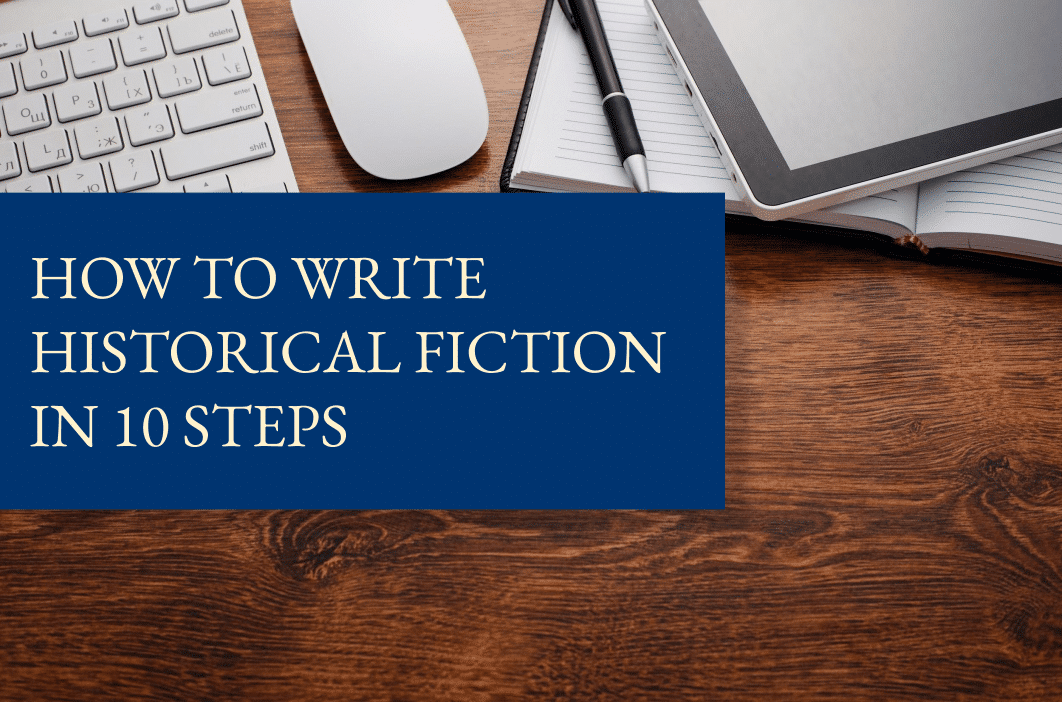
In this guide, we explain how to write historical fiction in 10 steps, breaking the process down into bitesize chunks to help you get started on your journey.
Writing historical fiction can be challenging, even for a seasoned writer. You have the usual things to worry about – planning, plotting, structure, character development, etc. – but on top of that, you also have to grapple with the in-depth research and get to grips with the key considerations around historical accuracy and authenticity.
For a newcomer, it can seem a bit daunting. But it needn’t be. If you follow these 10 steps, you’ll be ready to get started in no time.
Step 1: Develop your story concept
One of the great things about writing historical fiction is that history is a wonderful source of inspiration. There are a few different approaches you can take to utilising it:
1) Tell a fictionalised (but accurate) version of a true story. This includes biographical historical fiction, where the focus is on telling the story of someone’s life. The aim here is to explore the real events and characters of history with careful attention to accuracy. Of course, all or at least most of the dialogue will be fictional, and you may not know every detail of what happened, but the key is to create a story that accurately reflects what really happened as much as possible.
2) Tell a true story with some creative license. This doesn’t mean you can blatantly fabricate and falsify key elements of history, but it does mean you can draw on gaps in the historical record, subtext, and rumours in a way that a historian couldn’t. Just be honest with your reader in your historical note.
3) Use real events as the backdrop for your mostly fictional story. The aim here is slightly different. Yes, you’re basing the backdrop of your story on what really happened, but your core story is almost entirely fictional and will usually focus more on characters who are made up than renderings of real-life figures (though that’s not to say the story can’t have any real-life figures – it certainly can).
4) Use a true story as the inspiration for your fictional story. If you want to draw on the details of real events and people, but you feel your creative juices taking the story too far away from the real history, you might consider using history as inspiration for your story, rather than making it the story itself. This could involve basing a fictional character on a real person, for example, or taking inspiration from an interesting historical episode and replicating elements of it in your story. Just be careful to avoid basing your characters on people who are still living (for obvious legal reasons).
Step 2: Start your research
As the concept begins to take shape in your mind, it’s best to start learning more about your period and the key events and figures that might feature in your story.
Your first steps should be to figure out what you need to know and compile a list of resources that can help you attain that knowledge. Our 50+ top online research resources for historical fiction writers is a good place to start. Make sure to download your copy below.
50+ top online research resources for historical fiction writers
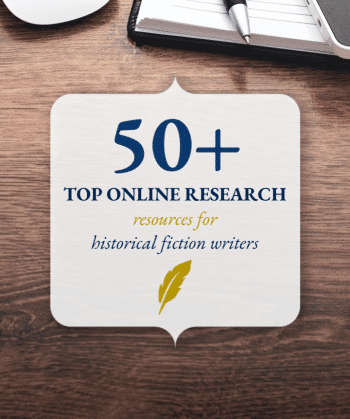
Aim to strike a good balance between primary sources (i.e. first-hand accounts of the period in question) and secondary sources (i.e. sources written after the period that describe and analyse it). Primary sources can give you an authentic flavour of your chosen era, and they can help you to reproduce authentic voices in your story as well, to say nothing of their value in providing a deeper insight into historical events. But secondary sources are also vital for providing you with a wider perspective on those events.
The further back your story is set, the harder it will be to find any pertinent sources at all. But remember, you’re not a historian. It’s part of your craft to fill in the gaps with your imagination. If something cannot be known, then so long as your interpretation feels plausible, it’s entirely legitimate to chart your own path. Just make sure you explain the gaps and how you filled them in your historical note.
When you’re doing your research, make sure you take plenty of notes, including recording where vital bits of information come from. Sources sometimes contain errors, so make sure you cross-reference them as much as possible. And check the provenance, too. The likely purpose of a source affects how we should read it, so pay close attention to who wrote it and why.
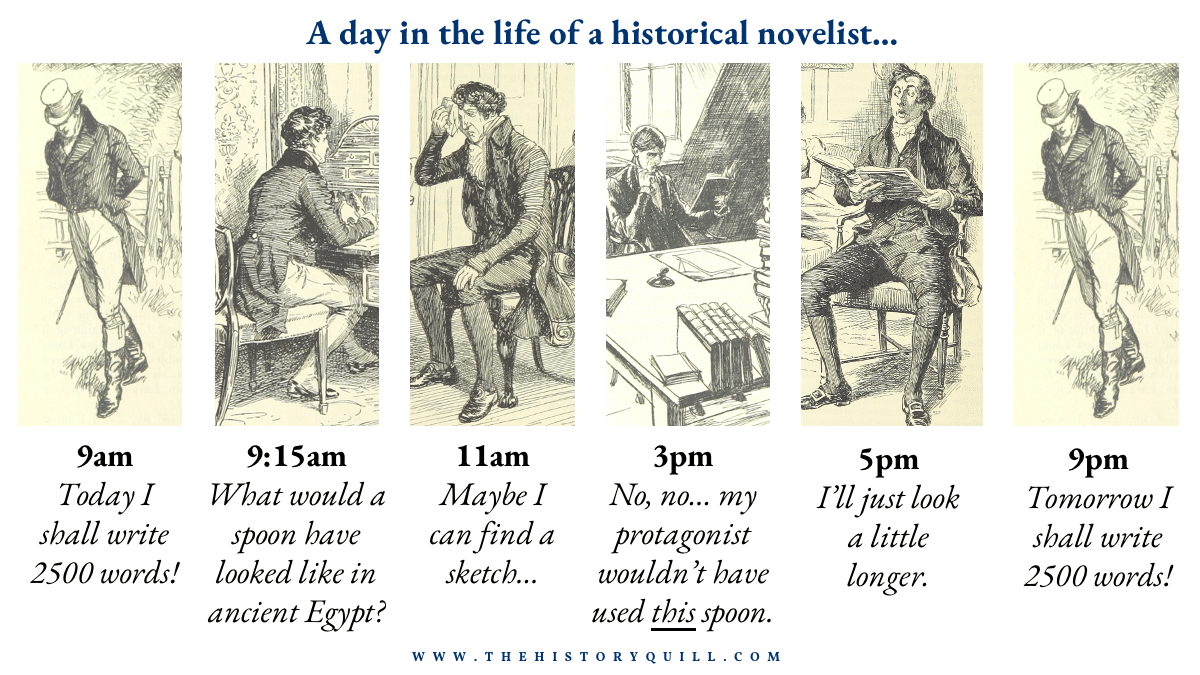
This scenario will be familiar to many historical fiction writers! Research never really stops, even when you’ve started writing. It’s easy to feel frustrated during periods when you spend more time researching than writing, but remember it’s all part of the same process.
Step 3: Strive for accuracy and authenticity
When people start thinking about how to write historical fiction, this is one of the areas that often comes to mind first – and for good reason. Historical fiction readers will primarily buy your book for two reasons: 1) because they’re looking for an absorbing, page-turning story, and 2) because they want to be immersed into a historical world that feels true to the period you’re writing about.
Your readers will expect you to accurately depict the details of every-day life as well as the wider political backdrop of your period. Readers will also have expectations when it comes to the treatment of historical events and real figures of history. Most will tolerate a little creative license as long as you justify it in your historical note, but filling your novel with numerous egregious falsehoods about easily verifiable facts is likely to get you into trouble.
You’ll also need to consider how people spoke and the common social conventions of your period. There’s little worse in a historical novel than a character speaking in modern slang or acting as if they’re in the 21st century.
For detailed guidance on how to achieve accuracy and authenticity in all of these areas and more, download our full guide on accuracy and authenticity in historical fiction.
Accuracy and authenticity in historical fiction
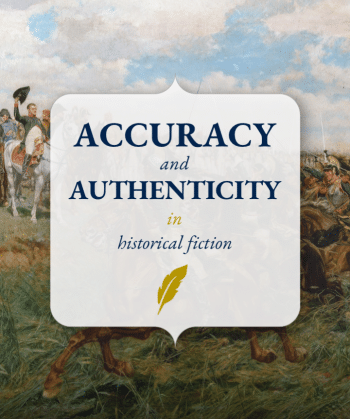
Step 4: Pick your structure
Structure is the foundation of fiction writing, so choose yours carefully. Here are four key structural decisions you’ll need to make:
1) What plot structure do you want to use? One of the most popular options is the three-act structure, which divides your novel into three acts corresponding to the beginning (roughly the first 25 per cent), the middle (about 50 per cent), and the end (the final 25 per cent).
2) What narrative structure do you want to use? This can be broken down further. Do you want just one chronological timeline in your novel, or do you want multiple timelines that take place in different periods? Do you want just one narrative point-of-view, or do you want to make it a multiple point-of-view story?
3) Which viewpoint do you want to use? The main options are first-person (I said), third person limited (he/she said), and third person omniscient (still he/she said but with an omniscient narrator).
4) Which tense do you want to use? In historical fiction, there are arguments for and against both past and present tense. Past tense feels more ‘historical’, but it also exacerbates the sense of a disconnect between the reader and the story. Present tense feels more ‘in the moment’, but it might jar with a story that’s so clearly set in the past. In the end, there’s no right or wrong answer; both are equally valid approaches with their own risks and benefits.
Step 5: Build your plot
A compelling plot requires numerous ingredients, but there are three that are most important of all:
1) A story question. A story question is just that – a question within your story. It’s the central question your reader wants to know the answer to as they turn the page. It’s also the question that gets answered in your resolution. Having a story question is important because it allows you to focus your plot on something clear and tangible and build the story around that. It can be something external to the characters, it can be something to do with the relationships between the characters, or it can be something related to the internal life of a character.
2) Conflict. Conflict is usually the main driving force behind plot. It refers to the clash between your main characters and the forces and obstacles that stand in the way of them achieving their goals. Conflict is essential because it puts the outcome of the story in doubt, creating a sense of jeopardy.
3) Stakes are the consequences of success or failure in your story. They’re why it matters whether or not your protagonist achieves their goal. Ask yourself what’s the worst that could happen if your protagonist fails and what’s the best that could happen if they succeed. The difference between the best and the worst outcomes is what makes your story matter. It gives your story stakes.
Step 6: Develop your characters
Rich, complex characters are vital for hooking your reader. Here are three key factors to consider when creating them:
1) Aims and motivations. Your characters should have aims that propel them forward, and motivations for wanting to achieve those aims. Without aims, your characters will come across as inert or directionless, and without motivations their aims will feel superficial and contrived. The two should always go hand in hand.
2) Internal conflict. Most stories involve a protagonist locked in conflict with an antagonist or fighting off some external threat. But, while external conflicts are essential for keeping the narrative going, internal conflicts are often what gives a story its emotional power. With internal conflict, your reader won’t just find themselves asking whether your characters are going to be able to overcome the external obstacles in front of them, they’ll also be forced to wonder what choices your characters are going to make. Are they going to do the right thing? Are they going to conquer their own demons? Will their own flaws prevent them from achieving the story goal? These questions will add an additional layer to your story.
3) Character growth. Your characters must evolve and grow over the course of your story. If they don’t, they’ll come across as too rigid and predictable, and it’ll feel like the story hasn’t had enough of an impact on their lives. One way to show growth is to have them resolve their internal conflicts by the end. Alternatively, they could conquer a fear or overcome something that was holding them back.
Step 7: Outline your story
If you’re a planner (rather than a pantser), then outlining your novel should occupy an important place in the creative process, sitting between the first sparks of imagination that kick off your new idea and the invigorating process of writing your first draft.
Once you’ve picked your structure and your plot and characters have started to come together in your head, it’s time to put everything down on paper. We’ve created a dedicated novel outline template designed especially for historical fiction writers to help you with this – make sure you download your copy below.
Novel outline template
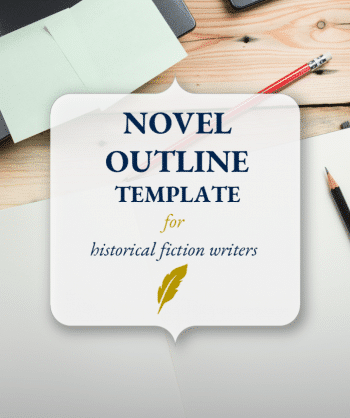
When you first start planning, the best approach is to start small. We suggest starting with a one sentence summary of your novel that captures the story question and features the main character. Then start adding more detail. A one paragraph summary should be next, including details of the antagonist and the key events. Obviously, you’re writing this for yourself, not as promotional material for your readers, so include everything – even the resolution. Next, try writing a one-page summary that expands on your paragraph. If you’re using the three-act structure, we recommend highlighting the key elements of it here (such as the end of each act).
Don’t overlook your characters. Include character profiles in your outline. In our template, we’ve suggested profiles for main and secondary characters and we’ve added some sections, such as character backgrounds, aims and motivations, and external/internal conflicts, that might be useful.
Step 8: Start writing!
Once you have a clear plan and your research is sufficient to create a rich, historically authentic setting, it’s time to start writing. It’s usually best to start from the beginning, but if you find that hard initially, you could start somewhere else before going back to the beginning when you feel more confident.
A lot of people write in Microsoft Word, but that’s not the only option. Scrivener is also a popular alternative word processor that’s designed especially for authors. If you prefer to dictate rather than write, Dragon is a popular tool.
We recommend using Grammarly to check your grammar as you write. It’s a great way of ironing out any writing tics as you go along, particularly things like errant commas, which can pile up over time. If you want to shop around, ProWritingAid is another option.
It’s often said that you need to write every day in order to finish a novel. That’s not necessarily true, but it is important to find a rhythm. Writing a novel takes time, patience, and discipline, so try and set a schedule and stick to it.
For support, accountability, and feedback while you’re writing, we recommend our group coaching programme for historical fiction writers.
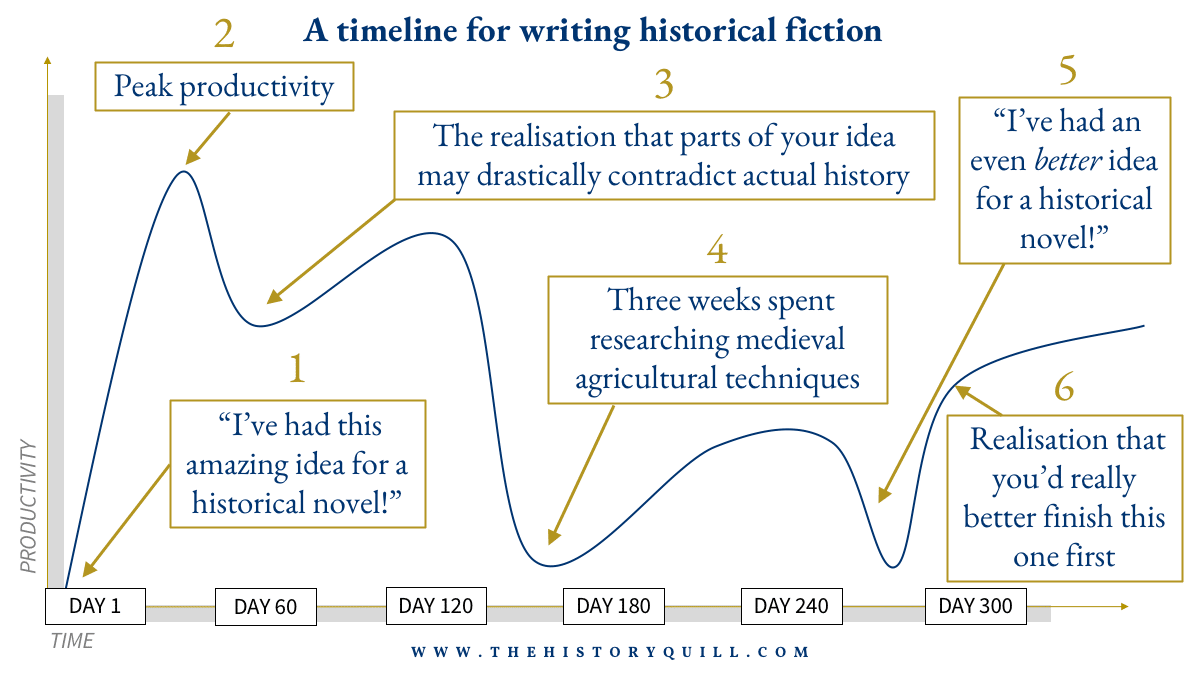
You won’t finish your first historical fiction book overnight. There will be plenty of hurdles along the way. Stick with it!
Step 9: Revise your first draft
You shouldn’t aim for perfection with your first draft. It’s an opportunity to get your ideas down on paper, primarily for your own benefit rather than anyone else’s. Some of it will probably be quite good, but some of it won’t be – and that’s fine. Once it’s finished, it’s time for your first round of revisions.
Ideally, take six weeks off from your manuscript after the first draft is finished. That way, you can start the revision process with fresh eyes. We recommend reading the whole thing through without any editing the first time; just make notes as you go along, recording what works and what doesn’t. When you’re done, review your notes and put together a short editing plan.
The next step is to go through each chapter making the necessary corrections, additions, and deletions. You’ll probably find that changes you make in one place have knock-on effects elsewhere. If so, note down the effects and pinpoint where you need to compensate for them.
Sometimes, all that’s needed is some tweaking. Other times, you might need to start entire sections of your novel from scratch. Either way, when you’re finished you should have a complete second draft. You might want to do an additional round of revisions at this point, or you might be ready to send it to an editor.
Step 10: Hire an editor
Once your manuscript is in reasonable shape, it’s essential to get a professional content edit. By the time you’ve reached this stage, you’ll know your manuscript inside out, but that proximity might prevent you from spotting errors that would be obvious to someone reading it for the first time. This is where a professional editor comes in.
But editors are more than just a fresh pair of eyes. They’re experts in story-craft, and they’ll help you take your manuscript to the next level by tackling its weaknesses and building on its strengths. They’ll help you turn your story into the best possible version of itself before you submit to agents or self-publish it.
So, those are the essential 10 steps explaining how to write historical fiction! If you ever feel like you’re getting stuck, come back to this guide and get yourself oriented. Remember, writing historical fiction is no easy feat, and it pays to take it one step at a time.
If you want to learn more about how to write historical fiction, check out our guide, Top tips on writing historical fiction from 64 successful historical novelists, here.
Do you write historical fiction?
Join our email list for regular writing tips, resources, and promotions.
